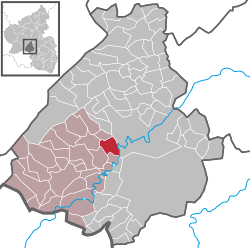Oberbrombach
| Oberbrombach | ||
|---|---|---|
|
||
| Coordinates: 49°41′57″N 7°15′42″E / 49.69917°N 7.26167°ECoordinates: 49°41′57″N 7°15′42″E / 49.69917°N 7.26167°E | ||
| Country | Germany | |
| State | Rhineland-Palatinate | |
| District | Birkenfeld | |
| Municipal assoc. | Birkenfeld | |
| Government | ||
| • Mayor | Helmut Brächer | |
| Area | ||
| • Total | 6.56 km2 (2.53 sq mi) | |
| Elevation | 474 m (1,555 ft) | |
| Population (2015-12-31) | ||
| • Total | 431 | |
| • Density | 66/km2 (170/sq mi) | |
| Time zone | CET/CEST (UTC+1/+2) | |
| Postal codes | 55767 | |
| Dialling codes | 06787 | |
| Vehicle registration | BIR | |
Oberbrombach is an Ortsgemeinde – a municipality belonging to a Verbandsgemeinde, a kind of collective municipality – in the Birkenfeld district in Rhineland-Palatinate, Germany. It belongs to the Verbandsgemeinde of Birkenfeld, whose seat is in the like-named town.
The municipality lies 8 km west of Idar-Oberstein and 10 km northeast of Birkenfeld.
In 1324, Oberbrombach had its first documentary mention. Ten or perhaps as many as twelve families lived here then. It can be assumed, though, that the village had existed long before that as a permanently populated place. In the document in question, twelve men are mentioned by name as having to vouch to Countess Loretta of Sponheim that they would prevent any flight from the land. Oberbrombach was thereafter a relatively important place for those days. It was at the time favoured by its location at the crossing of two ancient travel routes. The road from Metz by way of Birkenfeld to Oberstein crossed the way from the Moselle by way of Allenbach to the Frauenburg (castle) and on to the river Glan.
A good hundred years after the first documentary mention, the village was bereft of any villagers. Quite likely, those that had lived in Oberbrombach in the latter half of the 14th century had fallen victim to the Plague, which was rife in those days. In the 1438 Sponheim taxation book listing payments in kind, it was noted that ten considerable farmsteads were to be found in Oberbrombach, but that nobody dwelt there any longer. In 1465, four farmsteads were once more occupied. In 1563, twelve families were counted in the village; by 1607, this had risen to 27.
...
Wikipedia



